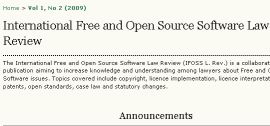How to Price a New Product
A lot of confusion on 101 how to do an initial price on go to market. Some thoughts.
Something to be reviewed in UC world, connections between these 2 technologies will simplify and deliver UC as a native app to all.
 If you're working on or launching an open source project, one of the most basic decisions you must make is which license the project will be released under, and choosing the perfect license is more complex than ever. Over the years, we've provided many free guidelines on this topic, but it's a moving target. In this post, you'll find our updeated collection of all the things you need to know to make an informed open source license decision.
If you're working on or launching an open source project, one of the most basic decisions you must make is which license the project will be released under, and choosing the perfect license is more complex than ever. Over the years, we've provided many free guidelines on this topic, but it's a moving target. In this post, you'll find our updeated collection of all the things you need to know to make an informed open source license decision.
The Free Software Foundation is the principal organizer of the GNU Project, and you can find the FSF's guidelines on choosing an open source license in this post. The guidelines cover how to choose an overall license for a project, and also cover making decisions on licensing modified versions of an existing project.
Through the FSF guidelines, you can gain knowledge about what Copyleft is, and it's wise to learn more about the GNU Lesser General Public License (LGPL), and the GNU Affero General Public License (AGPL). t's also worth looking into our post on the Software Freedom Law Center's Legal Issue Primer. It contains a very thorough discussion of most popular open source licenses. And you can find much more introductory material on open source licenses in this post.
These posts also provide much good background on licenses:
The Unlicense: A License For No License
FSFE and GPL-Violations.org on Reporting (and Avoiding) Licensing Issues
Thwarting Threats: Free OSS Legal Primer Boasts Big Authors
One reason to know about open source licenses is to keep things legal, and we have covered a number of legal resources that can help keep open source projects and developers out of harm's way. In this post, you'll find a discussion of a journal focused on open source law called International Free and Open Source Software Law Review. In the journal's archives, you'll find extremely informed discussions of licensing and patent practices, among other topics.
A little bit of homework can mean a lot when evaluating open source licenses. Hopefully some of the guidelines above will be of help to you.
Image courtesy of The International Free and Open Source Software Law Review.
Related Activities | Related Software | Related Blog Posts
|